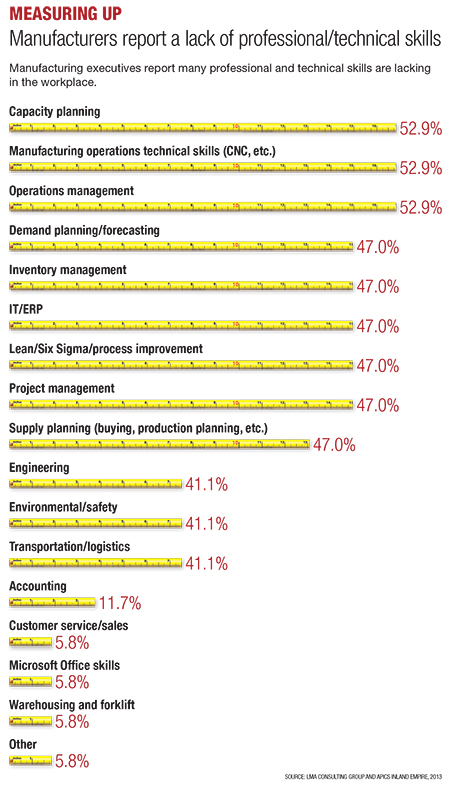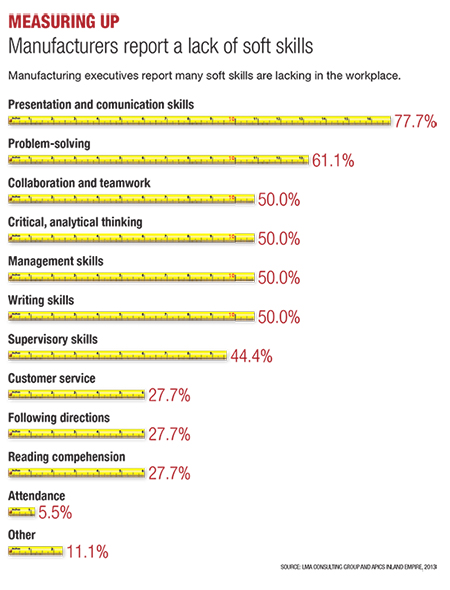Drive a buzz about manufacturing by making these changes within your company. In doing so, your employees become your cheerleaders

Eighty-seven percent of manufacturers and distributors are experiencing a skills gap, according to a skills gap survey completed by LMA Consulting Group Inc. and Southern California’s Inland Empire chapter of APICS. In essence, manufacturing and distribution executives do not have enough high-skilled talent to meet the increasing demand as end-to-end supply chains become increasingly complex, global and regulated.
As employees have become more comfortable in the economic recovery, they are much more likely to jump ship for better opportunities, retire or choose to leave to enhance their quality of life. Thus, the gap widens. Is there an opportunity to turn this gap into a way to drive interest in manufacturing careers? Yes, it goes hand-in-hand with attracting and retaining employees.
The research supports the critical importance of not just technical skills but also communication and presentation skills. These skills came in as No. 1 on the list of soft skills needed by manufacturers. The skills gap was the central topic at an executive panel and networking symposium sponsored by the APICS Inland Empire chapter, and the executives echoed this critical gap. Additionally, one of the panelists, Dr. Barbara Sirotnik, director of California State University San Bernardino’s Institute of Applied Research, said that these results coincided with her research results that the need for soft skills has now surpassed technical skills in importance for manufacturers.
Of our clients, at least 80 percent experience this shortfall in one way or another. Excellent ideas are too often passed up due to communication challenges, and mediocre ideas are implemented if presented effectively. These clients focused on lean initiatives, sales and operations planning programs and culture change initiatives. These initiatives tend to beat the odds since there is a focus on listening to feedback and providing training on how to present ideas and findings. In these cases, employees become more engaged, driving not only results but also an increased interest in manufacturing careers. Happy and engaged employees talk up their companies, thereby pulling top talent in the door and creating a buzz about the field.
Certainly, as much as soft skills are crucial to success, technical skills still play a vital role. According to the research, executives need a broad range of technical skills to ensure success. For example, a few of the top contenders include capacity planning, operations management, enterprise resource planning, lean manufacturing and CNC skills. And the list doesn’t stop there. In essence, manufacturers need “all-in-one” employee superstars.
What used to be considered high performance is relegated to the mediocre category. A common trend of our client base is that jobs are being combined, and managers are expected to handle not only a broad range of requests but also are required to go deep with these requests. For example, one of my aerospace clients has become highly competitive. In the process, the supply chain planning manager must manage planning processes, but virtually overnight is expected to include customer interaction and strategy deployment as it relates to the supply chain, along with a host of other tasks. In addition, a deeper planning acumen became a must. This manager is not alone. How executives choose to handle these situations can create employee engagement or an avid job searcher.
Undoubtedly, retention of top talent must become a higher priority. Seventy-seven percent of manufacturers are struggling to find qualified candidates, according to the skills gap survey. The research shows that succession planning and mentoring programs are tied as top contenders for retention strategies. However, manufacturers fall short in most cases, according to the executive panel. Thus, retention and development programs must become a key priority. The question becomes larger than just how to attract and retain top talent. Instead, the question becomes, how can we make manufacturing careers more attractive.
The bottom line is that top-notch manufacturing talent is in short supply yet the demand continues to increase. Those manufacturers that follow three core strategies for success will not only attract and retain top talent but will also make manufacturing careers more desirable and be more likely to outpace the competition. The three key strategies are:
- Communicate the vision
- Explain the value
- Provide opportunities to test ideas
Communicate the vision
Retaining top talent is not rocket science. Empower and engage your employees. So, why does it so rarely occur? It boils down to the lack of leadership. At the center of engaging and empowering employees is communicating the vision. For example, at PaperPak, the company struggled after absorbing too much too soon — a former P&G product line that was larger than the original business took the company global in one fell swoop, another company with a similar product line, a new ERP system and a new management team, just to name a few changes.
A new CEO came on board and rapidly clarified the vision. Even though it sounds insignificant, it turned out to be anything but inconsequential. From that point forward, everyone understood where the company was headed. It was not only communicated through regular channels but the grapevine also picked up the news. The CEO also brought key informal leaders under his wing to get them on board with the vision. News spread rapidly, and employees understood their purpose.
Explain the value
The next key strategy is explaining each team’s value and each employee’s value — in essence, how they contribute to the vision and goals. As a part of the performance management process, collaborating on just a few core goals to be accomplished each quarter will drive substantial results. First, management should clarify which goals should be the focus. This alone puts you ahead of the majority of companies. The discussion also adds meat to the bones. Employees better understand the goals from both a conceptual perspective and a tactical perspective. Suddenly, employees understand how they contribute value to the company, which goes a long way toward engaging employees.
For example, at PaperPak, the manager and employees formulate and discuss three key goals on a quarterly basis. Not only do employees gain insight into which goals are important and how the goals contribute value but they also feel valued through the process. Managers are busy. In 10 years and multitudes of clients, we have yet to come across a manager who wasn’t busy. Worse yet, the majority feel overloaded. Thus, putting aside time to meet with each employee on a quarterly basis demonstrated that the manager was investing time in the employee.
Lack of time is not a resource problem; it’s a matter of priority. Employees took note. The result was an accelerated pace of progress with substantial results. There were several examples but one that stands out is that the supply chain team was able to help the company reduce inventory by 40 percent to 50 percent while maintaining and improving service, including being awarded supplier of the year by their No. 1 customer through collaborative inventory management processes and tightly aligned goals.
Provide opportunities to test ideas
The third strategy to retain employees is to provide opportunities for employees to test ideas. This sounds much easier than it is to implement because failure is a par for the course. Great successes typically come after multiple failures. Leadership must be prepared to support failed attempts at innovation, even if they result in hits to financial performance. The true test to leadership occurs in his/her reaction to failure.
PaperPak’s CEO encouraged trials and supported smart failures. Of course, as cash was tight, dramatic failures could put the company out of business. Thus, assuming guidelines were clear and within reasonable tolerances, experimenting and creativity were encouraged and appreciated. There were many failed trials when designing and launching the core product line as the goal was to reduce product cost while improving product performance. This “win-win” objective could not be achieved without collaboration and innovation. The team knew it would be supported. More importantly, it knew it would be appreciated and recognized for its contributions to the company’s success. Therefore, long hours and failed attempts were just steps toward success; empowerment followed. The team achieved success with a rapid 12-month new product launch with a 5 percent to 10 percent reduction in product cost that spurred on substantial sales growth.
Undoubtedly, the same strategies required to retain top talent will attract new talent. It also can generate interest in manufacturing careers as folks have the opportunity to make a difference and be a key player in helping to achieve a compelling vision. Employees will leave if not paid fairly; however, pay is not a motivator. Having interest and an element of control over the nature of the work is a motivator. The key to success is for manufacturing leaders to spread the word and create excitement about the opportunities.
Take a step back and think about how quickly bad news travels. What if the manufacturing community was to take an active position in spreading positive news and generating excitement for the types of results and the significant impact top talent can have on success?
Put these core strategies in place and then partner with trade associations, universities, community colleges, former colleagues and even competitors to elevate the brand of manufacturing.
Published in “Association for Manufacturing Excellence”, Vol 30, No 4, Winter Issue 2014.



